Sudden Deaths For Endangered Antelopes
Air Date: Week of November 6, 2015
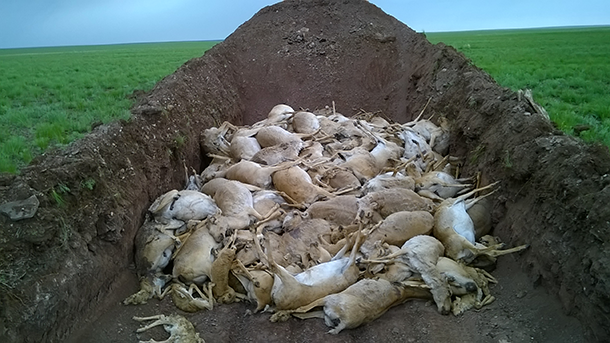
A mass saiga grave (Photo: Royal Veterinary College, Richard Kock)
The saiga, tawny, bulbous-nosed antelopes, have roamed the Central Asian steppe since the days of the woolly mammoth, but they’re dying by the hundreds of thousands. Dr. Richard Kock of the Royal Veterinary College of London tells host Steve Curwood that bacteria reacting to the effects of climate change may be to blame for this catastrophic event.
Transcript
CURWOOD: And now for a good news story at risk of going bad. With thousands of animals under threat around the world occasionally we hear of species being brought back from the brink. That includes the saiga, an antelope with a comical bulbous nose that once roamed by the millions across the vast grassland steppe from Central Europe to Mongolia. Hunters drove it to the edge of extinction before conservation efforts saved the tens of thousands left, and the population rebounded. But now the saiga are falling to a new mysterious disease that has already killed nearly 90 percent of some remaining populations. Experts recently gathered in Tashkent, Uzbekistan in an effort to solve this alarming puzzle, and Richard Kock, of the Royal Veterinary College in London was there. Dr Kock, Welcome to Living on Earth!
KOCK: It is a pleasure to be here.
CURWOOD: First, tell us a little bit about the Saiga. What does it look like?
KOCK: It's very unusual animal because it is a very ancient animal. It predates the mammoth. So, it's been wandering around in these large populations in the great steppe of Central Asia for tens of thousands of years and it is highly adapted to that very extreme environment where the temperatures range from minus 45 to plus 45 and it's sort of desert environment, desert steppe. So it's a tough life, and in order to survive they have to have certain adaptations. So, they're ruminants, probably one of the oldest ruminants on Earth actually, and that enables then to get the best out of the vegetation, and they have to filter the air very carefully because when it's so cold, it would freeze their lungs. So they have this extraordinary nose, a bit reminiscent of an elephant's trunk, and it sort of flaps, and it also helps with vocalization. It's a bit like the wildebeest, people will know the wildebeest sounds, it's a bit like [MIMICS SAIGA SOUND]. It's part of its way of communicating when it's migrating. They migrate over huge distances. The other characteristics, one of the fastest hoofed animals, it does up to 70 miles per hour.
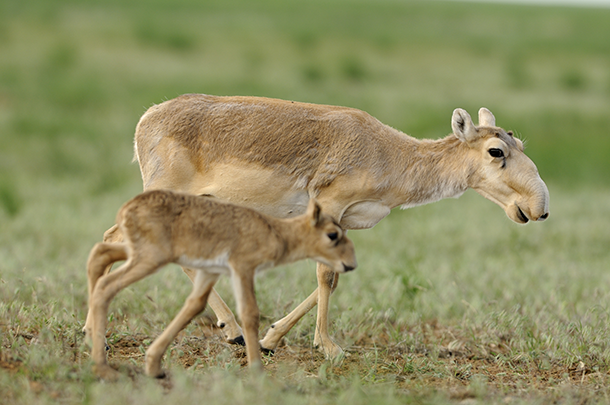
Mother saiga and her calf (Photo: US Fish and Wildlife, Igor Shpilenok, CC BY 2.0)
CURWOOD: Whoa, that's a fast antelope.
KOCK: This is partly a predator avoidance. You would've had large wolf packs, not so much nowadays but in the past. I mean, they still have wolf predation, and there are a few other species they have to watch out for. So, they've adapted to that landscape, but they are definitely from pre-history and they look like it.
CURWOOD: So what was your reaction when you found out about this mass die-off of Saigas earlier this year?
KOCK: I'll give you the background. There actually was another die-off in 2010 in the Western population that's right next to Russia, and there was a second event in 2011, and I was asked to come and sort of do a retrospective assessment of what had happened, and so I went there to spend time, gathering evidence really around that die-off. Around 15,000 animals died in that event, and so that sort of started a train of events. We got to know the Kazaks a bit and we recommended that we do a monitoring program on an annual basis because these animals come together to calve; they aggregate, a bit like the wildebeest and others. They come and aggregate in quite large groups and produce their calves before they start running again on their migratory path. So, you have an opportunity every year to look at them closely, look at the mortality, and look at their reproduction and so on. So we were doing this every year since 2012, and so we were actually on site when this mortality started, and that was a unique opportunity to get good information and samples and so on for diagnostic purposes, and it was extremely shocking.
CURWOOD: What was it like to see all these animals dead on the landscape?
KOCK: Well, it was, you know, watching it from the beginning, animals start dying. So one or two is not unexpected. It started with just a few, and then gradually gathered pace and over two or three days—I mean, the best description is that they were dying like flies. Eventually the landscape was completely littered with these mammals. Very distressing, because from moving and eating normally to death was just a matter of hours. So it was hopeless. You wouldn't have had a chance of doing much to help individuals and then the calves sadly were dying after their mothers, so they...as their mothers died...these animals were very distressed. So they'd be running around bleating and not sure what to do. So, pretty distressing.
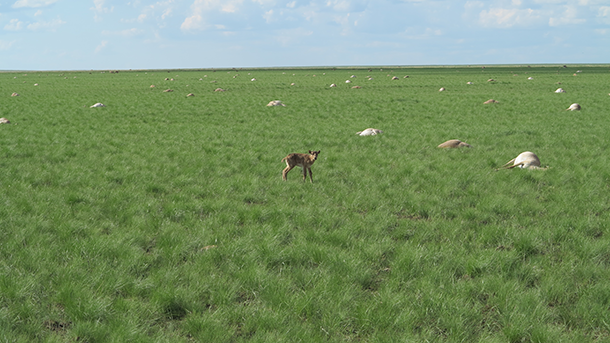
One living saiga with carcasses littering the landscape (Photo: Royal Veterinary College, Alexa Wolfs)
CURWOOD: With all of this, how many Saigas are now left?
KOCK: Well, you know we...sort of part of this ongoing activity there has been census work where they do an aerial count. That's a particular technique where you fly and then you do transects and you count and then you use a formula to estimate what the total population is. And so the population was growing nicely. From 2014 when I was there and we were so pleased to see a big population, maybe as many 300,000 animals going off into the sunset at the end of calving and it was most encouraging to see. And the count taking the death that would've taken place over winter in early May or late April was about 250,000 in that central population. There are other populations, smaller ones in the west of about 50,000, one in the south about 2,000, and one in Mongolia of about 14,000, and a small population in Russia of a few hundred. And the central population is the key population. And so we had 250,000 and then after the die-off, we monitored two sites, one of 60,000, one of 8,000 and then gradually became clear that they were about 15 die-off sites, these aggregations of animals, and the die-offs occurred at all those 15 sites, and the government agreed to do a census after this event to try and establish actually the mortality was, and using the method - there's always an error using aerial counts - so there the best survival number was 30,000 out of that 250,000. So we know roughly 220,000 the population had died, and in all those aggregations and the ones we monitored, the very surprising thing was it was 100 percent, I mean, both getting sick and dying, so that is very, very unique. I've worked in this field of infectious diseases for 35 years and I have never seen anything like that.
CURWOOD: So what are the leading notions about what happened to these animals?
KOCK: Yes, so from an epidemiological perspective, it was too quick to be an infectious disease. For transmission of an organism, like a cold virus or pathogen or something would take weeks if not months to move through a population of that size. So this whole event was more or less over in a matter of days. So we knew epidemiological this couldn't be a transmissible infection, an epidemic if you like in the conventional sense. And so we have to explore what else might be going on and we used various methods to sample and to culture and try to identify organisms that might be involved, and in all the cases we examined - we did 32 very in-depth postmortem examinations - and we were able to show this bacteria called Pasteurella multocida or a particular serotype that's associated with a disease call hemorrhagic septocemia.
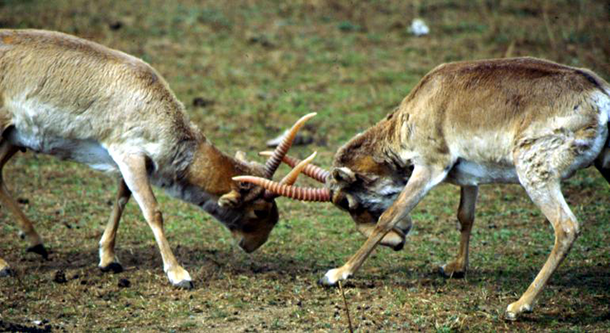
Two healthy saiga sparring (Photo: US Fish and Wildlife, Richard Reading CC BY 2.0)
CURWOOD: Well, wait a second. You're talking about a bacteria that generally is transmissible...
KOCK: Yeah, it can be, but in this case there wasn't time for that. So, what's characteristic about this bacteria is we call it a commensal parasite, which means that it can be latent. So in your intestine you have lots of bacteria which are your friends, basically, they help you to resist other bacteria, other pathogens, and they give balance and they help balance your immune system, and they're on your skin, too, you have many of these bacteria which are very helpful to you. Well this is not a helpful bacteria, but it can be a very neutral bacteria, so it can sit on the mucus membrane of your throat and not do anything, just live there, living off the nutrients that are available. And in that stage it's of no problem but, occasionally they can change and they have this ability to become virulent, and what I mean by that is it that they then can invade the body and cause a disease, and we've known this for many years in domestic animals and we also know of events caused by this organism in wildlife too. Even the North American bison actually, back in the '20s, they lost a lot related to this organism. So, we can confirm that that organism is involved.
CURWOOD: OK, so these microbes are there all the time. What you think set them off?
KOCK: Yeah, that's the big question. We have some evidence from these opportunist-type bacteria that they can be, for example, temperature sensitive. So if the temperature goes up in the environment where the bacteria live, then they can switch to virulence, and it sort happens through the genes actually melting, you get a sort of melting effect. If can you imagine sort of the DNA has structure, and with heat bends and changes and that enables it now to enter the cells more easily and contributes to its ability cause disease. So temperature is something that we are looking at and how that might have affected the bacteria. The other thing is stress of some kind. This disease in domestic animals has often been associated with things like transportation, if you put cattle in the truck and drive them across United States, quite often they get what is called transport fever and that was related to this Pasteurella type organism. So we know stress is involved, so the immune system is involved, and the question is what led to the immune system collapsing across a whole population. I think it's getting that idea that we talking about an area of 250,000 square kilometers. We're talking about 15 populations varying from a few thousand to 60,000 in each of those aggregations. We're talking about synchronicity in terms of the individuals as to their suddenly getting this disease. I mean it's the most extraordinary phenomenon. It's like somebody waved a wand.
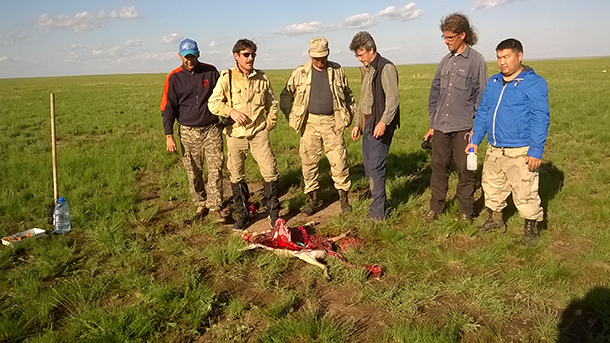
Scientists standing over a saiga carcass. (Photo: Royal Veterinary College, Richard Kock)
CURWOOD: So how could say the weather and perhaps climate change have played a role here, do you think?
KOCK: Yes, so that's a good question because clearly we need to look at some overarching factors. Something in the environment that was affecting all the animals in the sense at the same time they developed this disease. So we did look for weather triggers, and just prior to the start, the temperatures had risen quite rapidly to levels of up to 37 degrees, so quite hot and then suddenly they dropped. So we had sort of a weather front come through and it caused extreme drop in temperature from around 37 down to minus 5 over about 24 hours, plus rain plus wind. You can imagine these animals which are at peak energy demand, they’ve just produced three young lambs, they are producing a lot of milk, it's a very stressful time for them, and then suddenly having lost their fur coats as well because they dropped the coat they have in winter for a summer coat, and so they have no insulation now. So they suddenly get this shock, and we know again with domestic animals it's often associated with that sort of shock, so that may affect the immune system, that may trigger the bacteria and that looks like the most likely factor.
CURWOOD: Let me just take a moment to remind some of our listeners who aren't as fluent in the metric system as most of the world is that we're talking about Fahrenheit nearly 90 degrees going down to in the 20s overnight.
KOCK: Correct. So it's very extreme and even though the animals are adapted this is a point in time when they're actually vulnerable to getting a hell of a chill. So we suspect that this is at the root of the main trigger, but there's something deeper in it because if we look now retrospectively we see that 10, 15 years ago the pattern of temperatures was in a lower range. So in these environments, the temperatures are rising. I think this is a climate change effect. With climate change we're seeing greater fluctuations and this is an example of it I think, where the temperatures are rising very high at a time of year when that would not normally happened and they are dropping very precipitously so the range of drop is much greater than would've happened maybe 200 years ago, 300 years ago. So, in a sense what we have here is a perfect storm and the thresholds for something like this to happen are reducing, and we can probably blame climate change for that.
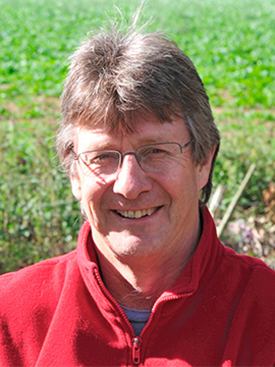
Dr. Richard Kock is a wildlife veterinarian, researcher and conservationist. (Photo: Royal Veterinary College of London)
CURWOOD: In the meantime what are conservationists and scientists like you doing on the ground to try to save this creature?
KOCK: So we're going to continue to work closely. We have a team of international scientists from different disciplines who are going to look at a whole range of factors, and I think if we can understand this disease and the triggers and predict them, then we might be able to take measures to help them. It's not like the Serengeti where you have hundreds of different antelope and it's a very diverse system and if you lose one species I don't think most of the tourists would notice. You know, we're talking about the main mammal of this ecosystem system and everything else depends on it. So the wolves will go, a large number of species will go if this animal goes, and the steppe will become silent. That to me is why it's so important. We have to recognize this is a large area of the planet and it could go quiet and that it would be such a tragedy.
CURWOOD: Richard Kock is an expert on wildlife disease. He's at the Royal Veterinary College in London. Richard, thanks so much for taking the time with us today.
KOCK: Great pleasure. Thank you.
Links
Dr. Richard Kock teaches at the Royal Veterinary College of London
More on the saiga and the investigation into their mysterious deaths
Living on Earth wants to hear from you!
Living on Earth
62 Calef Highway, Suite 212
Lee, NH 03861
Telephone: 617-287-4121
E-mail: comments@loe.org
Newsletter [Click here]
Donate to Living on Earth!
Living on Earth is an independent media program and relies entirely on contributions from listeners and institutions supporting public service. Please donate now to preserve an independent environmental voice.
NewsletterLiving on Earth offers a weekly delivery of the show's rundown to your mailbox. Sign up for our newsletter today!
 Sailors For The Sea: Be the change you want to sea.
Sailors For The Sea: Be the change you want to sea.
 The Grantham Foundation for the Protection of the Environment: Committed to protecting and improving the health of the global environment.
The Grantham Foundation for the Protection of the Environment: Committed to protecting and improving the health of the global environment.
 Contribute to Living on Earth and receive, as our gift to you, an archival print of one of Mark Seth Lender's extraordinary wildlife photographs. Follow the link to see Mark's current collection of photographs.
Contribute to Living on Earth and receive, as our gift to you, an archival print of one of Mark Seth Lender's extraordinary wildlife photographs. Follow the link to see Mark's current collection of photographs.
 Buy a signed copy of Mark Seth Lender's book Smeagull the Seagull & support Living on Earth
Buy a signed copy of Mark Seth Lender's book Smeagull the Seagull & support Living on Earth

